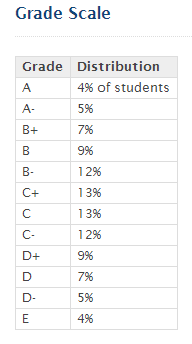Grade Scale
-
Toggle ItemGrade Scale
A course's grade scale can be access by navigating to the desired course and then click on the Grades tab.
1. Click Grade Scale on the left side navigation to view the course grade scale.

BYU Learning Suite offers four grade scales for instructor use:
- Percent
- Points
- Scaled Points
- Distribution
Percent
Grades are based on the percentage of points earned from the total points possible. The column on the right displays the minimum percentage students must earn to receive the corresponding letter grade shown in the column on the left.
Note: Final grades are truncated to two decimal points. For example, 92.995 will appear as 92.99.

Points
Grades are determined by the number of points earned from the total number of points possible. The column on the right displays the minimum total points students must earn in order to receive the corresponding letter grade shown in the column on the left.

Scaled Points
Grades are determined in a mix between points and percent. The instructor sets a maximum points possible for the grade scale that does not need to equal the number of actual points possible in the course.
For example, if the maximum points possible is 1000 and the actual points possible is 680, the course will be scaled accordingly. This means that if you get 550 out of 680 actual points possible you would get 808.5 out of 1000 maximum points possible ((1000/680) x 550 = 808.5).

Distribution
This scale could also be referred to as “grading on a curve.” Distribution scales are used to target a certain GPA. The column on the right shows the percentage of students that will achieve each letter grade.
For example, the grade scale below shows that an A grade is reserved for the 4% of students with the highest scores, and that an A- grade is reserved for the 5% of students with the next highest scores.
Note: Distribution grade scales reflect a student’s grade compared to the other students in the class. Grades are subject to change throughout the semester depending on student performance. Additionally, the distribution will not reflect the true impact of missing or ungraded assignments.

-
Toggle ItemWeighted Categories
The weighted categories grading method means that each category will be given a certain percentage, or weight, of your grade. The assignments within a category will be averaged together to determine the score of that category.
Example:
Grades will be based on a series of short quizzes, four exams, and a writing assignment. The quizzes combined will be worth 20% of your grade (each quiz has equal value), a written assignment in two parts will be worth 20% of your grade (10% for each part), the two in-class music identification exams will be worth 20% of your grade (10% each), and the two Testing Center exams will be worth 40% (20% each).If your instructor has chosen the weighted categories method, you can view the weight of categories on your final grade by going to the Assignments page and looking at the numbers in the % of Grade column.